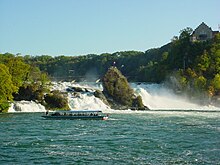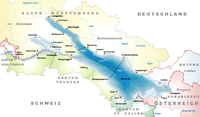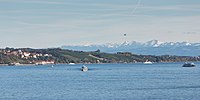High Rhine
| High Rhine (Hochrhein) | |
|---|---|
 Upper part of the High Rhine nearDörflingen | |
 Sections of the River Rhine: High Rhine | |
| Location | |
| Country | Germany |
| State | Baden-Württemberg |
| Districts | Konstanz,Lörrach,Waldshut |
| Country | Switzerland |
| Cantons | Aargau,Basel-Landschaft,Basel-Stadt,Schaffhausen,Thurgau,Zürich |
| Physical characteristics | |
| Source | |
| • location | Lower Lake Constance(Untersee) inStein am Rhein |
| • coordinates | 47°39′53″N8°51′31″E/ 47.664762°N 8.858715°E |
| • elevation | 395 m |
| Mouth | |
• location | Basel,continues as theUpper Rhine(Oberrhein) |
• coordinates | 47°33′37″N7°35′23″E/ 47.560148°N 7.589726°E |
• elevation | 252 m |
| Length | 165 km (103 mi) |
| Basin size | 24900 km2 |
| Basin features | |
| Tributaries | |
| • left | Aare,Birs,Ergolz,Glatt,Möhlinbach,Sissle,Thur,Töss |
| • right | Alb,Biber,Durach,Murg,Wehra,Wutach |
High Rhine(German:Hochrhein,pronounced[ˈhoːxˌʁaɪn];kilometres[a]0 to 167 of the RiverRhine)[2]is the name of the part of the Rhine betweenLake Constance(Bodensee) and the city ofBasel,flowing in a general east-to-west direction and forming mostly theGermany–Switzerland border.It is the first of four named sections of the Rhine (High Rhine,Upper Rhine,Middle Rhine,Lower Rhine) between Lake Constance and theriver deltaat theNorth Sea.[3]
Name
[edit]The termHigh Rhinewas introduced by scientists in the 19th century.[citation needed]Above all geologists tried to differentiate the High Rhine (German:Hochrhein) linguistically from theUpper Rhine(French:Rhin Supérieur,German:Oberrhein). Until the 19th century, it was also known as the 'Badisch-Swiss Rhine'.[4]It lends its name to theHigh Rhine Railwayline, which to a great extend follows the river to the north of it.
Geography
[edit]Course
[edit]The High Rhine begins at the outflow of the River Rhine from theUntersee(Lower Lake Constance) inStein am Rheinand turns into theUpper Rhineat theRhine knee(Rheinknie) in Basel (more precisely at theMiddle Bridge). It is marked by Rhine-kilometers 0 to 167, with the measurements beginning at the outflow from theObersee(Upper Lake Constance) at theOld Rhine BridgeinKonstanz(Constance), although the part between the Upper and Lower Lake Constance is distinguished as theSeerhein(English:Lake Rhine) and the part of Lower Lake Constance through which the Rhine flows is known as theRheinsee.Therefore, the High Rhine begins at Rhine-kilometer 25.45.[2]
In contrast to theAlpine Rhine(the maintributaryof Lake Constance) and Upper Rhine, which both flow mainly in a south-to-north direction, the High Rhine flows mostly from east to west. BetweenSchaffhausenand the confluence with theTöss,it flows from north to south for about 20 km (12 mi), with a distinctmeanderatRheinau.In its eastern portion, the river passes through theMolasse basin(passing south of theHegauregion), while in its western part it traverses theTable Jurabefore entering theUpper Rhine Plainat Basel, where it turns northwards.[5]
In its western section, the High Rhine mostly marks the borderbetween Germany and Switzerlandexcept in theSwiss cantonofBasel-Stadt.In the eastern part, there are several disconnected areas of Switzerland to the north of the river (canton of SchaffhausenandRafzerfeldof the canton of Zurich). The GermanenclaveofBüsingen am Hochrheinis located on the northern bank of the High Rhine, surrounded by Swiss territory.

Tributaries
[edit]Apart from many creeks, largertributariesof the High Rhine are, in the order of theirconfluences,theBiber,Durach,Thur,Töss,Glatt,Wutach,Aare,Alb,Murg,Sissle,Wehra,ErgolzandBirs.The High Rhine's drainage basin measures 24,900 km2(9,600 sq mi).[3]
With 557 cubic metres per second (19,700 cu ft/s), the Aare has a larger discharge than the Rhine (439 cubic metres per second (15,500 cu ft/s)).[6]From a hydrological point of view, therefore, the Rhine is a tributary of the Aare, not vice versa. The Rhine is, however, generally considered the main stream, because it is slightly longer than the Aare.
Waterfalls and rapids
[edit]
TheRhine Falls(Rheinfall), which are the largest plainwaterfallsofEurope,are in themunicipalitiesofNeuhausen am RheinfallandLaufen-Uhwiesen,near the town ofSchaffhausen.They are 150 metres (490 ft) wide and 23 metres (75 ft) high. In the winter months, the average water flow is 250 cubic metres per second (8,800 cu ft/s), while in the summer, the average water flow is 600 cubic metres per second (21,000 cu ft/s).
The rapids in the High Rhine should be viewed in the context of the relatively high slope—from 395 to 252 metres (1,296 to 827 ft)a.s.l.in just 165 kilometres (103 mi)—and the change of the river's course during theWürmice age.In Neuhausen am Rheinfall, the river falls into a previously buried stream channel, forming the Rhine Falls at Schaffhausen. The next rapids are the Kadelburg Rapids atKoblenz.NearLaufenburg,the post-glacial Rhine failed to find the old silted-up channel and hit a spur of Black Forest crystal. The river cut itself a gorge, containing the Laufenburg Rapids. The Laufenburg andSchwörstadtRapids have been artificially eliminated by blowing up the rocks and raising the water level with dams.
Interventions
[edit]


The character of the river has been changed over long distances by the construction ofhydropower stations.The Laufenburg and Schwörstadtrapidswere removed by blowing up rocks, originally to improve navigation, and later flooded due to the hydropower dams.
BetweenStein am RheinandDiessenhofen,the High Rhine is notdammed.The first power plant along the Rhine is located in Schaffhausen; it has a damming effect to slightly above Diessenhofen. The next power plant (Kraftwerk Reckingen) is located atRekingen[b]andKüssaberg.After Rekingen, the High Rhine flows freely through the Koblenz Rapids to the confluence with theAare.The next hydropower plant (theKraftwerk Albbruck-Dogern), is atLeibstadtandDogern.There are seven more power plants between here and Basel. Altogether, the High Rhine has eleven dams and twelve hydropower plants (there are two plants at theAugst/Wyhlen Dam.
Towns and organizations
[edit]Some parts of the High Rhine valley are fairly wide, while others are more gorge-like. The population density varies accordingly. Prominent towns on the High Rhine include Stein am Rhein, Schaffhausen, Neuhausen am Rheinfall,Waldshut,Laufenburg,Bad Säckingen,RheinfeldenandBasel.Some towns on the lower section of the river, which here corresponds to theGermany–Switzerland border,are located on both banks, such asLaufenburg(Aargau) andLaufenburg (Baden)andRheinfelden(Aargau) andRheinfelden (Baden).
The most important organizations for cross-border cooperation on the High Rhine are High Rhine Commission[7]and High Rhine Agency.[7]
Authorities on the Baden-Württemberg side of the river are organized in a framework calledRegionalverband Hochrhein-Bodensee( "Regional cooperation High Rhine — Lake Constance" ).
Bridges
[edit]
Several bridges cross the High Rhine, including a few historic ones. Examples are (in direction of waterflow):Eglisau railway bridgeinEglisau,Waldshut–Koblenz Rhine BridgebetweenKoblenzandWaldshut-Tiengen,thewooden bridgebetweenSteinandBad Säckingenor theMiddle BridgeinBasel.The old wooden bridge betweenGailingenandDiessenhofenis low so that during times when the water level of the river is high, large ships can no longer pass underneath it.
Important regions
[edit]Numerous areas along the High Rhine are currently, or were historically considered important. From west to east, they areDinkelberg,Augstgau,Fricktal,Table Jura,Albgau,Aargau,Hotzenwald,Klettgau,Zurzibiet,Zürichgau,HegauandThurgau.
Transportation
[edit]Shipping
[edit]There are passenger boat lines on the lower High Rhine[8]and betweenSchaffhausenandKonstanz.[9]There are also boat tours betweenEglisauand theRhine Falls,including the Rhine Falls Rock.[10]
Railway
[edit]TheHigh Rhine Railwayline follows the lower section of the river (betweenBasel Bad BfandWaldshut) along its northern banks, but then runs further north to it in its upper section (except in Schaffhausen).
On the Swiss side, the river is followed by (from west to east) theBözberg railway line(betweenPrattelnandStein-Säckingen) theKoblenz–Stein-Säckingen railway line(section betweenLaufenburgandKoblenzis closed to passenger trains), theWinterthur–Bülach–Koblenz railwayline (between Koblenz andEglisau), theEglisau–Neuhausen railway linebetweenNeuhausen RheinfallandNeuhausen(briefly venturing through German territory through theJestetter Zipfel), theRheinfall Railwayline (betweenDachsenandSchaffhausen), and theLake Linebetween Schaffhausen andStein am Rhein.
The High Rhine is crossed by (from west to east) theBasel Connecting Line(betweenBasel SBBand Basel Bad Bf), theTurgi–Koblenz–Waldshut railway linebetween Koblenz and Waldshut, the Eglisau–Neuhausen railway line (betweenEglisauandHüntwangen-Wil), the Rheinfall Railway line (betweenSchloss Laufen am Rheinfalland Neuhausen), the Lake Line betweenFeuerthalenand Schaffhausen, and theEtzwilen–Singen railwayline (betweenEtzwilenandHemishofen,used as aheritage railwayonly).
See also
[edit]Notes
[edit]- ^The kilometrage of the River Rhine begins at theOld Rhine Bridgein the city ofKonstanz(Constance) and ends at theHook of Hollandat theNorth Sea.[1]
- ^The town ofRekingenon the Swiss side of the river spells its name with -k-; the village on the German side spells its name with -ck-; since the power station is on the German side, it uses the -ck- spelling
References
[edit]- ^"Rheinkilometrierung[Rhine kilometrage] "(in German).Retrieved22 June2024.
- ^ab"Der Hochrhein[The High Rhine] "(in German).Retrieved22 June2024.
- ^ab"Überblicksbericht der Flussgebietsgemeinschaft Rhein zur Bewirtschaftungsplanung nach Wasserrahmenrichtlinie für den 3. Bewirtschaftungszeitraum"(PDF).FGG Rhein. 10 December 2020.Retrieved7 June2024.
- ^Valenta, Reinhard (1997). "Eine Landschaft im Wandel; Der Hochrhein zwischen Waldshut und Rheinfelden [A changing landscape; the High Rhine between Waldshut and Rheinfelden]". In M. Bosch; A. Enderle; H. Fricker; R. Valenta (eds.).Der Hochrhein.Karlsruhe: G. Braun. pp. 6–29.
- ^"Geology of Switzerland".Nagra.Retrieved24 June2024.
- ^"High Rhine".ICPR – International Commission for the Protection of the Rhine.Retrieved15 June2024.
- ^ab"Home".hochrhein.org.
- ^"Schifffahrt Rheinfelden – Basel[Boat trip Rheinfelden–Basel] ".Retrieved8 June2024.
- ^"Schifffahrtsgesellschaft Untersee und Rhein (URh)[Boat trip Schaffhausen–Konstanz] ".Retrieved8 June2024.
- ^"Schiffmändli".Ernst Mändli AG.Retrieved8 June2024.
Further reading
[edit]- Andreas Gruschke:Der Hochrhein. Eine alemannische Flusslandschaft.Schillinger, Freiburg im Breisgau, 1995,ISBN3-89155-183-5




